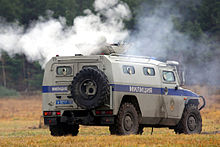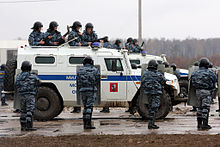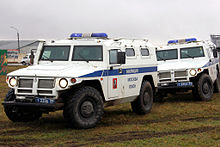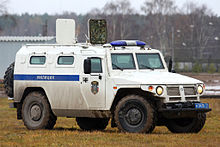- OMON
-
Отряд милиции особого назначения 
Active 1979-Present Type Special Operations Role Paramilitary unit, Domestic Counter-Terrorism and Law Enforcement 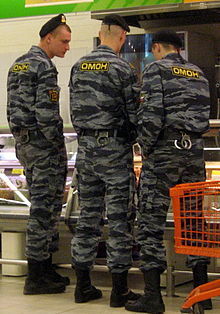 Saint Petersburg OMON servicemen, while shopping on duty. 2008
Saint Petersburg OMON servicemen, while shopping on duty. 2008
OMOH (Russian: Отряд милиции особого назначения; Otryad Militsii Osobogo Naznacheniya, Special Purpose Police Unit) (ОМОН) is a generic name for the system of special units of militsiya (police) within the Russian and earlier the Soviet MVD (Ministry of Internal Affairs). As of 2008, there is an OMON unit in every oblast of Russia, as well as in many major cities; for example, there is an OMON unit within the Moscow City police department, and two separate units within Moscow Oblast police department. OMON also continues to exist in Belarus and some other post-Soviet territories following the dissolution of the Soviet Union.
In 2011, The Russian OMON units are to be renamed Distinctive Purpose Teams (KON), while OMSN will become Special Purpose Teams (KSN).[1] It was announced that such Special Purpose Centers for Rapid Deployment forces will be also created in Russian regions, to include regional OMON and OMSN units. In essence, all police spetsnaz units will be brought together under the joint command of the Interior Ministry[2] - The Center for Operational Spetsnaz and Aviation Forces of MVD (Центр специального назначения сил оперативного реагирования и авиации МВД России).
Contents
History
OMON originated in 1979, when the first group was founded in preparation for the 1980 Summer Olympics in Moscow, to ensure that there were no terrorist attacks like the Munich massacre during the 1972 Summer Olympics. Subsequently, the unit was utilized in emergencies such as high-risk arrests, hostage crises, as well as in response to acts of terrorism. The OMON detachments were often manned by former soldiers of the Soviet Army and veterans of the Soviet war in Afghanistan.
The OMON system itself is the successor of that group and was founded in 1987, with the commando duties largely taken over by the SOBR (dangerous criminals) and Vityaz (counter-terrorism) units of the MVD. The OMON units were initially used as the riot police used to control and stop demonstrations and hooliganism, as well as other emergency situations, but later became accustomed to a wider range of police operations, including cordon and street patrol actions, and even paramilitary and military-style operations.
High-profile operations
- On January 20, 1991, the Soviet Riga OMON attacked Latvia's Interior Ministry, killing six people during the January 1991 events following the republic's declaration of independence.[3] Seven OMON members were subsequently found guilty by the Riga District Court and received suspended sentences.
- A series of attacks on border outposts of the newly-independent Republic of Lithuania during the January–July 1991, resulting in several summary execution-style deaths of the unarmed customs officers and other people (including former members of Vilnius OMON), were attributed to Riga OMON;[4] some sources say that the Soviet leader Mikhail Gorbachev had lost control of the unit. Lithuanian government continues to demand that the persons suspected in these incidents should be tried in Lithuania; one suspect was arrested in Latvia in November 2008.[5]
- Violent and often armed clashes between the Georgian SSR's OMON and the opponents of the first Georgian President Zviad Gamsakhurdia prior to the Georgian Civil War of 1991-1993.
- The April–May 1991 Operation Ring by the Azerbaijan SSR OMON and the Soviet Army against the Armenian irregular units in the Nagorno-Karabakh Autonomous Oblast, resulting in several dozen people killed and the forced displacement of thousands of ethnic Armenians.
- Prior to the creation of the Armed Forces of the Republic of Azerbaijan, the bulk of the fighting in Nagorno-Karabakh on the Azeri side was conducted by the post-Soviet OMON units and irregular forces. This included the defence of the village of Khojaly by the force of Azeri OMON and volunteers against the Armenian insurgents and the Russian Army forces prior and during the Khojaly massacre on February 25, 1992; most of the group involved died during the ensuing slaughter in which several hundred of Azeri civilians died.
- The Moscow OMON and units brought from the other cities clashed with the anti-Yeltsin demonstrators order during the 1993 Russian constitutional crisis, reportedly even beating up some members of the Supreme Soviet of Russia (the Russian parliament at the time).[6]
- Cordon duties during the Russia's mass hostage crises, including the 1995 Budyonnovsk hospital hostage crisis, the 2002 Moscow theater hostage crisis and the 2004 Beslan school hostage crisis.
- Breaking up of several opposition rallies (including Dissenters' Marches since 2006), sparking reports of police brutality, including excessive use of force and arbitrary detention of participants.[7] In November 2007, the brutal actions of OMON against peaceful demonstrators and arrests of opposition figures were harshly criticised by the European Union institutions and governments.[8]
- On March 24, 2006, Belarusian OMON stormed the opposition's tent camp at the Minsk October Square without provocation, violently ending the peaceful Jeans Revolution against the regime of Alexander Lukashenko. Thousands of people were beaten and hundreds detained as the result of the attack, including the opposition's presidential candidate Alaksandr Kazulin.[9]
- In June 2007, the Moscow OMON prevented gay rights activists (including the European Parliament members) from marching after Moscow mayor Yury Luzhkov did not allow a planned parade to take place.[10]
- In August 2008, the South Ossetian separatist OMON took part in the fighting with the Georgian national forces during the 2008 South Ossetia war and were accused of "special cruelty" in the ethnic Georgian villages.[11] Subsequently, South Ossetian OMON fighters were included into Russian regular forces in area as a contract soldiers and continued to be deployed in the highly-disputed Akhalgori zone.[12]
In Chechnya
The force was active in the First Chechen War where the unit was used as light infantry and in the notorious "mopping-up" operations (zachistka).[13] In February 1996, a group of 37 officers of the Novosibirsk OMON were captured by the Chechen militants during the Kizlyar-Pervomayskoye hostage crisis;[14] 17 of them were later swapped for the Chechen fighters captured in the same incident. In August 1996, group of 30 Chechen OMON members answering to Said-Magomed Kakiyev were reportedly captured and executed in Grozny, the Chechen capital, during the battle for the city.
OMON is active in the Second Chechen War. Almost every Russian city sends, on a regular basis, small units of police (often composed of OMON members) for tours of duty in Chechnya lasting several months, while the Chechen Republic also formed its own OMON detachment. The force sustained heavy losses in the second conflict as well, including from the March 2000 ambush which killed more than 30 OMON servicemen from Perm (including nine captured and executed),[15] the July 2000 suicide bombing which inflicted more than 100 casualties at the Chelyabinsk OMON base in Argun,[16] and the April 2002 attack which killed 21 Chechen OMON troops in central Grozny.[17]
Control and discipline is questionable in Chechnya, where the members of the group were noted to engage in or fall victim of several deadly friendly fire and fratricide incidents. In the bloodiest incident, at least 24 Russian OMON officers were killed and more than 30 wounded when two units (from Podolsk and Sergiyev Posad) fired on each other in Grozny on March 2, 2000.[18] Among other incidents, several Chechen OMON servicemen were abducted and executed in Grozny by the Russian military servicemen in November 2000,[19] members of the Chechen OMON clashed with the Ingush police on the Chechen-Ingush border resulting in eight fatalities and about 20 injuries in September 2006,[20] and the Ramzan Kadyrov-controlled Chechen OMON clashed with a group of rival Chechens belonging to the Kakiyev's GRU commando unit in Grozny, resulting in five dead and several wounded in 2007.
In the course of the Chechen conflict the OMON was accused of severe human rights abuses,[21] including abducting, torturing and killing civilians. As of 2000, the bulk of war crimes recorded by international organisations in Chechnya appeared to have been committed by the OMON.[22] An OMON detachment from Moscow region took part in the April 1995 rampage in the village of Samashki, during which up to 300 civilians were reportedly killed in the result of a "cleansing operation" conducted there by the MVD forces.[23] The OMON unit from Saint Petersburg[24] is also believed to be behind the Novye Aldi massacre in which at least 60 civilians were robbed and then killed by the Russian forces entering Grozny in February 2000;[25] one officer, Sergei Babin, was reported to be prosecuted in relation to the case in 2005 and then to disappear.[26][27] In 1999 a group of unidentified OMON members shot dead around 40 refugees fleeing Grozny.[28]
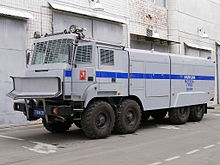 Moscow OMON riot control water cannon police vehicle "Lavina-Uragan" on Ural-532362.
Moscow OMON riot control water cannon police vehicle "Lavina-Uragan" on Ural-532362.
In April 2006, the European Court of Human Rights found Russia guilty of the forced disappearance of Shakhid Baysayev, a Chechen man who had gone missing after being detained in a March 2000 security sweep by the Russian OMON in Grozny.[29] In 2007, the Khanty-Mansi OMON officer Sergei Lapin was sentenced for kidnapping and torture of a Chechen man in Grozny in 2001,[30] with the Grozny court criticising the conduct of the OMON serving in Chechnya in broader terms.[31] In an event related to the conflict in Chechnya, several OMON officers were accused of starting the May 2007 wave of the ethnic violence in Stavropol by assisting in the racist murder of a local Chechen man.[32]
Before and early during the First and Second Chechen Wars, there were also OMON formations belonging the Interior Ministry of the Chechen Republic of Ichkeria, Chechnya's separatist government.[33]
OMON in Russia
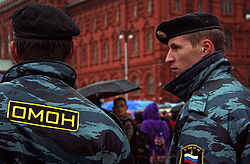 OMON personnel in Red Square, Moscow
OMON personnel in Red Square, Moscow
Information from different sources suggests that there were between 10,500 and 15,000 OMON members stationed at population centers and transportation hubs around the country in the 1990s, yet by 2007 this number officially rose to about 20,000 nationwide (as referenced to as Innner Armed Forces). The biggest OMON unit in Russia Moscow OMON has over 2000 members. Members receive a comparatively small salary of about $7,000 per month in Moscow (regional units offer less)[citation needed]. Most members retire at the age of approximately 45 years. They are also sometimes not paid for their service (in 2001, for example, some 50 OMON members from Moscow filed the lawsuit claiming they were not paid for one month of combat operations in Chechnya[34]). Due to the use of OMON members in high risk situations, especially in Chechnya and elsewhere in North Caucasus, the group often loses members in combat.
Members of OMON are supposed to be extremely fit and experts in small arms and hand-to-hand combat. Males between the ages of 22 and 30 who have completed their two-year military service can apply to join OMON (the application includes medical and psychological tests, and tests of speed and fitness). The initial training lasts for four months. The applicants are extensively trained in the use of different weaponry and close combat, and are also trained to follow orders at any cost. Special emphasis is put on urban combat and the entering and clearing of buildings. The training also includes legal training. The application procedure closes with a final test, where the applicant has to fight three to five trained members of OMON by hand wearing boxing gloves. Fewer than one in five applicants pass and are selected to join.
The OMON groups use a wide range of weapons, including but not limited to AK-74 assault rifle, AKS-74U carbine assault rifle, 9A-91 compact assault rifle, and PP-19 Bizon submachine gun. OMON units during a combat operations may also use other weaponry typical for the Russian light infantry (the OMON troops in Chechnya were sometimes called "OMON soldiers" in the reports,[35] especially in the so-called active phases of the conflict), such as the PK machine gun, the GP-25 underbarrel grenade launcher for AK-74 or the GM-94 pump-action grenade launcher, and the Dragunov and Vintorez sniper rifles.
OMON vehicles include specially-equipped vans, buses and trucks of various types, as well as limited number of armoured personnel carriers (BTR-60, BTR-70 and BTR-80). OMON's headgear remains a black beret (they are thus sometimes called "Black Berets") although otherwise there were significant changes in uniform and insignia. The group members often use the blue urban camouflage uniforms and black face masks while on duty, and various Russian Army and Internal Troops uniforms while in Chechnya. OMON of the Chechen Republic also frequently wear American-made military uniforms similar to these often used by the separatist fighters.
See also
- Rus - A counter-terrorist and emergency situations unit of the Russian MVD
- SOBR - A system of the Russian MVD special units specializing in combating dangerous criminals
- SWAT - The American model for the initial OMON squads
- Vityaz - Another counter-terrorist unit of the Russian MVD
- Berkut - Ukrainian version of OMON
References
- ^ Moscow News, 22 August 2011: Retooling Russia's Riot Police
- ^ http://www.agentura.ru/english/projects/control/policereforms2011/
- ^ BBC News, 27 March 2007: Timeline: Latvia
- ^ Pasienio apsaugos tarnyba // Fight for Independence 1990-1991 (English)
- ^ Novaya Gazeta, 29.11.2008: The unmasked face
- ^ Memorial, April 1994: HUMAN RIGHTS VIOLATIONS UNDER THE STATE OF EMERGENCY IN MOSCOW DURING THE PERIOD FROM NOON, OCTOBER 4 TO OCTOBER 18, 1993
- ^ Amnesty International, 16 April 2007: Russian Federation: Attack on public dissent
- ^ (Polish) Polska Agencja Prasowa, November 26, 2007: Milicja biła opozycję, Europa oburzona (Dziennik Polska-Europa-Świat)
- ^ TIME, March 25, 2006: Belarus: 'They Knocked My Husband Down and Dragged Him Away'
- ^ The Associated Press, May 27, 2007: Russian Police Detain Gay Activists (The Washington Post)
- ^ The Georgian Times, September 15, 2008: “Resistance does not make any sense: they will kill us on the spot”
- ^ Imedi TV, October 16, 2008: Ossetian militiamen join Russian regular army (trans. BBC Monitoring)
- ^ Human Rights Watch, February 1995: Russia: Three Months of War in Chechnya
- ^ The Independent, January 20, 1996: Fog of battle clouds Pervomayskoye's ugly truth
- ^ The Sunday Times (UK), 9 April 2000: Chechens wipe out Russia's top troops (Center for Defense Information)
- ^ People's Daily, July 03, 2000: Chechen Truck Bomb Kills at Least 25 Russians
- ^ The St. Petersburg Times, April 19, 2002: Mine Leaves 21 OMON Troops Dead
- ^ The Independent, January 15, 2002: Russia invented ambush by Chechens to hide friendly-fire massacre
- ^ European Court of Human Rights, 2007-11-15: CASE OF KUKAYEV v. RUSSIA
- ^ The Moscow Times, September 14, 2006: 7 Dead in Police-OMON Battle
- ^ The Washington Post, June 2, 2000: Civilian Massacre Fits Pattern Of Earlier Human Rights Abuse
- ^ Institute for War and Peace Reporting, April 5, 2000: Chechens Rub Salt in Old Wounds
- ^ Memorial, 1996: By All Available Means: The Russian Federation Ministry of Internal Affairs Operation in the village of Samashki: April 7-8, 1995
- ^ Institute for War and Peace Reporting, August 9, 2007: Chechen Massacre Survivors See Justice
- ^ Human Rights Watch, June 2000: FEBRUARY 5: A DAY OF SLAUGHTER IN NOVYE ALDI
- ^ Los Angeles Times, July 03, 2005: An Unlikely Antiwar Hero for Russians
- ^ Prague Watchdog, July 27th 2007: ECHR on Russian war crimes: responses from Moscow and Grozny
- ^ The Independent, December 6, 1999: Rebels inflict heavy losses as Russian forces close on Grozny
- ^ Prima, April 11, 2005: European Court of Human Rights finds Russia guilty in disappearance of man in Chechnya
- ^ The St. Petersburg Times, April 1, 2005: Chechen Court Sends OMON Officer to Jail
- ^ Amnesty International, 31 March 2005: Russian Federation: Russian police officer found guilty of crimes against the civilian population in the Chechen Republic
- ^ Radio Free Europe/Radio Liberty, June 7, 2007: Russia: Ethnic Tensions Mounting In Restive Stavropol
- ^ Interview with the Chechen field commander Dalkhan Khozhaev
- ^ Gazeta.ru, 27 June 2003: Moscow policemen want Chechen money
- ^ Google: "OMON soldiers" search results
External links
- Unofficial OMON webpage
- The Kingdom of OMON, The eXile, May 18, 2007
Law enforcement in Russia Ministry of Internal Affairs (Police · Traffic Police Dept. · Internal Troops · OMON) · Federal Protective Service (Presidential Security Service) · Federal Security ServiceCategories:- Acronyms
- Law enforcement in Belarus
- Law enforcement in Russia
- Law enforcement in the Soviet Union
- Special forces of Russia
- Non-military counter-terrorist organizations
Wikimedia Foundation. 2010.

